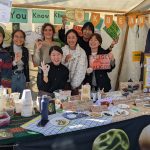
In the last weeks, the Global Bean team has been busy gathering, preparing and sending out the winner packages. How lucky we are to receive and pass on such fabulous bean diversity coming from across Europe!
Who would have thought origami skills could come in handy? Well they did, and the Global Bean team repackaged the seeds in hand-made envelopes, labeld with the name of the bean and of the seed provider. Then, the precious seeds were wrapped in bubble wrap, so that the seeds would not get crushed by the machines used in by postal services. Additionnaly, a poster from the Global Bean team was also added to the packages, and they were ready to be sent out.
Currently on their way are beans from five seed providers:

1- Twelve bean varieties provided by ÖBZ (Ecological Education Centre) based in Munich, German. You can see them on the picture: Royalty, Red Calypso, Flagg, Monstranz, “Türkische Erbsen” (Turkish Peas), Facta, Saxa, Debs’Creek, “Spatzeneier” (Sparrow’s eggs), Kroatische Stange (Croatian Pole), St. Andreas, and Massliebchen. You can find more info about them on the ÖBZ Catalog (In German).
2- A mix of homegrown beans from Nicolas Carton, in Munzingen, Germany in 2021. @lumineuses_div (Germany). Among them, you will find the following varieties:

1.“Genoll de Crist”, 2.“Klosterfrauen”(Covent Women), 3.“Kaiser Friedrich”(Emperor Friedrich), 4.“Wildtäler”(Wild valleys), 5.“Forellenbohne” (Trout bean), 6.“Neckarkönigin”, 7. “Kirschbohne”(Cherry Bean), 8. “Blauhilde”.
Photo: courtesy of Nicolas Carton (@lumineuses_div)

3- A mix of “Körnerbohnen” beans from Patrick Kaiser, Genbänkle (Germany). He prodivded seeds through his company Tatgut.

4- Beans from ZMAG (Albania): Kukuruzar, Kornjaš – black turtle beans-, and Zelenček, small traditional beans.
5- The beans Fagiolo Nano di Trento, Zolfino di Toscana and Jacob’s Cattle offered by Aldo Matteuchi (Norway). Pro tip for these beans: these are small plants, so there is no need for support! They also need well drained soil without water stagnation.
Thanks to all the contest participants and a BIG THANK YOU to the seed-providers 🌱
As a reminder, Christine Scheiner won the flower contest with Pisum Sativum, Gabi Horn won the plant contest with Cowpea, and Susan Young won the Seed Contest with Domaci Cucak.

Chrisine Scheiner – Pisum Sativum

Gabi Horn – Cowpea

Susan Young – Domaci Cucak
All pictures submitted are worth looking at tough, so, as a reminder, you can find the beautiful pictures of the contest participants at the Bean Gallery. We highly recommend having a look.
As a conclusion: We hope you all have enjoyed this contest as much as we did. We will learn from this experience and prepare an even better Bean Beauty contest for next year! Stay tuned for that, and the next contests and competitions from the Global Bean Project!
>>Check out the fastest bean competition!
The winners of the Bean Beauty Contest are getting their winner packages!

In the last weeks, the Global Bean team has been busy gathering, preparing and sending them out. How lucky we are to receive and pass on such fabulous bean diversity coming from across Europe!
Who would have thought origami skills could come in handy? Well they did, and the Global Bean team repackaged the seeds in hand-made envelopes, labeld with the name of the bean and of the seed provider. Then, the precious seeds were wrapped in bubble wrap, so that the seeds would not get crushed by the machines used in by postal services. Additionnaly, a poster from the Global Bean team was also added to the packages, and they were ready to be sent out.
Currently on their way are beans from five seed providers:

1- Twelve bean varieties provided by ÖBZ (Ecological Education Centre) based in Munich, German. You can see them on the picture: Royalty, Red Calypso, Flagg, Monstranz, “Türkische Erbsen” (Turkish Peas), Facta, Saxa, Debs’Creek, “Spatzeneier” (Sparrow’s eggs), Kroatische Stange (Croatian Pole), St. Andreas, and Massliebchen. You can find more info about them on the ÖBZ Catalog (In German).
2- A mix of homegrown beans from Nicolas Carton, in Munzingen, Germany in 2021. @lumineuses_div (Germany). Among them, you will find the following varieties:

1.“Genoll de Crist”, 2.“Klosterfrauen”(Covent Women), 3.“Kaiser Friedrich”(Emperor Friedrich), 4.“Wildtäler”(Wild valleys), 5.“Forellenbohne” (Trout bean), 6.“Neckarkönigin”, 7. “Kirschbohne”(Cherry Bean), 8. “Blauhilde”.
Photo: courtesy of Nicolas Carton (@lumineuses_div)

3- A mix of “Körnerbohnen” beans from Patrick Kaiser, Genbänkle (Germany). He prodivded seeds through his company Tatgut.

4- Beans from ZMAG (Albania): Kukuruzar, Kornjaš – black turtle beans-, and Zelenček, small traditional beans.
5- The beans Fagiolo Nano di Trento, Zolfino di Toscana and Jacob’s Cattle offered by Aldo Matteuchi (Norway). Pro tip for these beans: these are small plants, so there is no need for support! They also need well drained soil without water stagnation.
Thanks to all the contest participants and a BIG THANK YOU to the seed-providers 🌱
As a reminder, Christine Scheiner won the flower contest with Pisum Sativum, Gabi Horn won the plant contest with Cowpea, and Susan Young won the Seed Contest with Domaci Cucak.

Chrisine Scheiner – Pisum Sativum

Gabi Horn – Cowpea

Susan Young – Domaci Cucak
All pictures submitted are worth looking at tough, so, as a reminder, you can find the beautiful pictures of the contest participants at the Bean Gallery. We highly recommend having a look.
As a conclusion: We hope you all have enjoyed this contest as much as we did. We will learn from this experience and prepare an even better Bean Beauty contest for next year! Stay tuned for that, and the next contests and competitions from the Global Bean Project!




